Gain control over Kubernetes environment
Gain full visibility and control over your Kubernetes environment

In 2025, managing Kubernetes costs is critical as cloud expenses can rapidly escalate without proper optimization. Kubernetes cost optimization tools go beyond monitoring, autonomously managing resources, and intelligently scaling to minimize waste while improving performance. Tools like Sedai utilize AI and reinforcement learning to continuously adjust resources in real-time, eliminating the need for manual intervention and ensuring cost-effective, efficient operations.
As engineering leaders, you know the challenge: Kubernetes offers incredible flexibility and scalability, but it can quickly spiral into an expensive and complex beast if not properly managed.
Traditional cost management tools only go so far. They may alert you to inefficiencies, but they often leave you with the burden of fixing them. That’s where the shift to autonomous systems comes in.
McKinsey’s research shows organizations that align cloud adoption with business outcomes achieve a 180% return on investment, whereas those that migrate legacy workloads without optimization often wait 12–18 months to break even. With Kubernetes becoming the de facto orchestration layer for microservices, engineering teams need tools that not only visualize costs but also act on them autonomously.
That is why we have created this guide that reviews leading Kubernetes cost optimization tools for 2025 to help you make informed decisions.
Kubernetes cost optimization is the process of managing and reducing cloud spending when using Kubernetes clusters. As organizations scale their applications in Kubernetes, cloud infrastructure costs can grow quickly if not carefully managed. Kubernetes enables flexibility and scalability, but without proper oversight, resources can become over-provisioned, idle, or inefficiently utilized, leading to unnecessary expenses.
Effective Kubernetes cost optimization focuses on minimizing waste, ensuring that resources are allocated based on actual demand, and maintaining a balance between cost, performance, and reliability.
That balance can’t come from static rules alone. Workloads shift, traffic patterns evolve, and what made sense last week might be wasteful today. The real opportunity in Kubernetes cost optimization lies in systems that continuously learn and adjust without forcing engineers to micromanage every configuration. Otherwise, you are just moving the problem from your cloud bill to your engineering backlog.
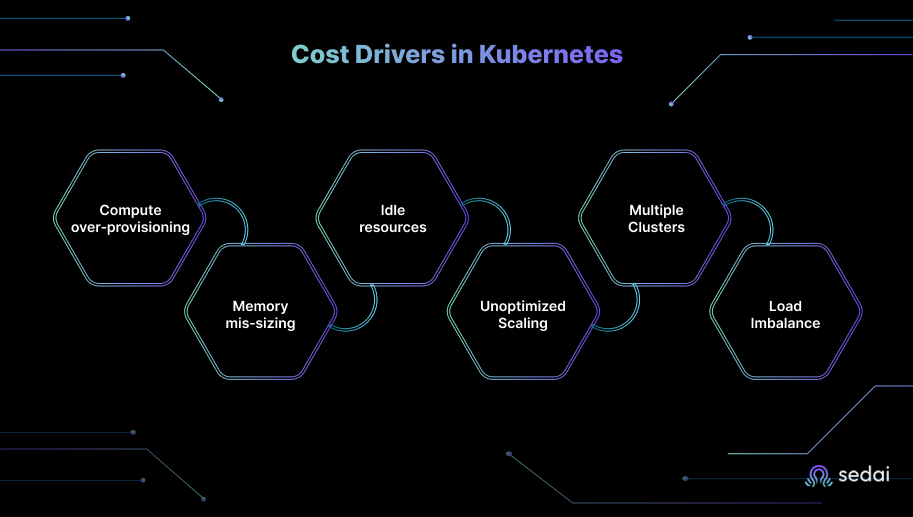
If you want to get serious about Kubernetes cost optimization, you first need to understand where the money is slipping through the cracks. After sitting with dozens of engineering teams, we’ve noticed the same cost drivers repeat themselves, whether the cluster runs a handful of services or hundreds.
Here are the most common ones:
These drivers are not just technical missteps. They are symptoms of a system that relies heavily on human configuration. As long as cost control depends on manual tuning of requests, scaling thresholds, and workload placement, inefficiencies will persist. That is why more teams are starting to look for systems that don’t just highlight these issues but adapt in real time to prevent them in the first place.
Kubernetes cost optimization tools are specialized software solutions that help address these cost drivers. They allow organizations to track, monitor, and manage the costs associated with running Kubernetes clusters by providing insights into resource usage, workload allocation, and scaling policies.
These tools help engineering teams and cloud administrators optimize their Kubernetes environments by offering capabilities like:
However, before reviewing tools, it's essential to understand that not all tools are created equal. It’s worth understanding the difference between automated and autonomous platforms. Automated systems execute predefined rules, for example, “if CPU>70 % for 5 minutes, add one pod”, but they are brittle. Any change in workload or architecture requires manual rule updates.
Autonomous systems, on the other hand, learn context, adapt to change, and act independently. They reduce human toil and catch inefficiencies before they cause outages. Moving from automation to autonomy delivers three significant outcomes: fewer nights spent firefighting, lower cloud costs through continuous rightsizing, and improved performance and availability.
The right tools can make all the difference when it comes to managing Kubernetes clusters at scale. Over the years, we’ve seen engineering teams experiment with a wide range of tools to streamline operations: scheduling, deployments, observability, cost management, security, and more.
But here’s the problem we keep running into: Traditional approaches to cost and performance management force a trade-off that rarely works in practice. These tools warn you about issues but leave your team to solve them manually.
This gap is precisely why autonomous systems are becoming essential. They don’t just point out problems: they act on them, reducing the cognitive load on teams while keeping both costs and performance in check.
Let’s start with the one that actually lives up to that promise.

When we say Sedai is #1, we’re not just throwing out a catchy phrase. It’s not about the shock value, but rather the approach. Most tools rely on rules-based automation. You set thresholds, and when usage crosses them, the system reacts. That works until workloads shift unexpectedly, and then the rules break.
What sets us apart is our patented reinforcement learning framework, which powers safe, self-improving decision-making at scale. Instead of just automating responses, it learns from your workloads, models how applications behave, and continuously improves its decisions with every change. That feedback loop is what keeps optimizations reliable, cost-effective, and aligned to performance goals.
That’s why a growing number of engineering teams are now using AI platforms like Sedai.
Sedai supports both autonomous scaling and co-pilot-based executions, where users are empowered to make key decisions on which workloads to execute, while the system handles other scaling actions automatically.
Sedai autonomously:
This real-time intelligence is what sets Sedai apart. Where most platforms show you what’s wrong, Sedai actually fixes it, adjusting commitments, rightsizing resources, and tuning workloads without manual input.
For enterprises, this means:
Key Features:
Best for: Engineering leaders who need continuous optimization across performance, availability, and cost. Enterprises adopting multi‑cloud or hybrid strategies and seeking to reduce manual effort will benefit most.
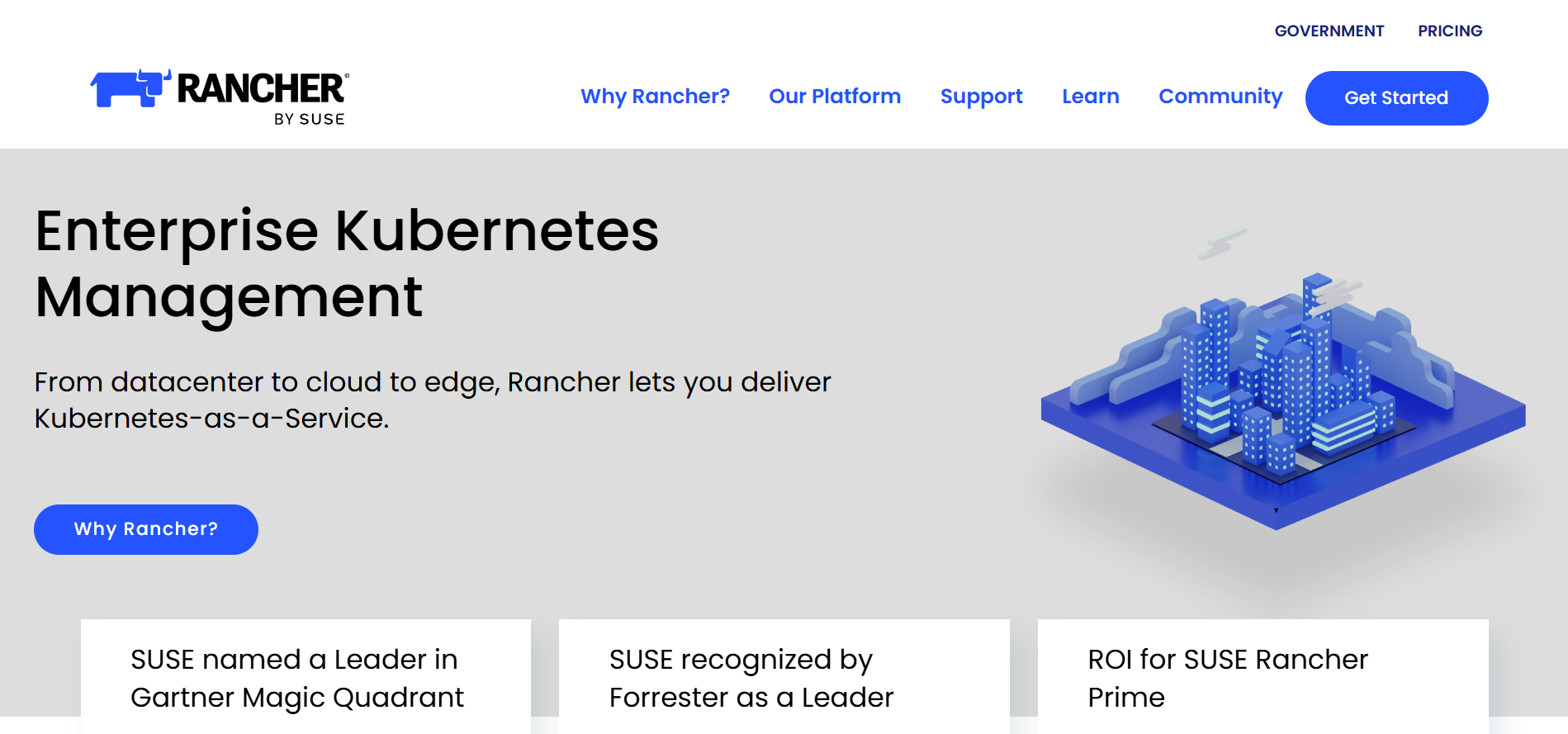
Rancher is a platform for managing Kubernetes clusters across on‑premises and public clouds. It provides a central control plane where administrators can create, upgrade, and monitor multiple clusters. Rancher abstracts away differences among providers, enabling consistent configuration and policy enforcement.
Key features:
Best for: Enterprises operating many clusters across different providers or on‑premises. Teams needing unified governance and RBAC controls will find it valuable.

Lens is a desktop application that gives developers an intuitive graphical interface for interacting with Kubernetes clusters. It aggregates multiple clusters into a single workspace, making it easier to explore resources, monitor pods, apply configurations, and troubleshoot issues.
Key features:
Best for: Individual developers and small teams who need to interact with multiple clusters without mastering command‑line operations. It is suited for local development as well as production cluster monitoring.
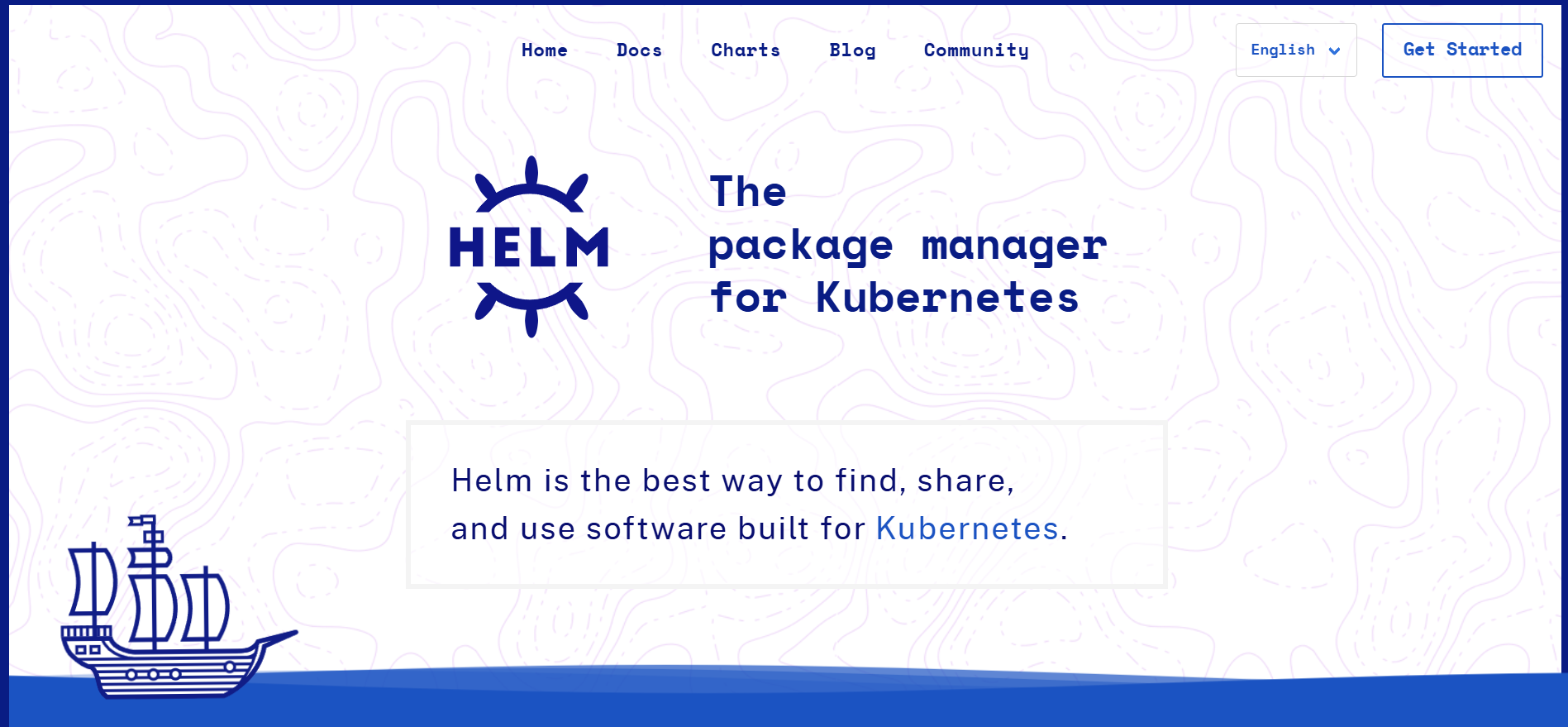
Helm is the de facto package manager for Kubernetes. It allows teams to define, install, and upgrade complex applications using “charts”, versioned templates containing Kubernetes manifests. Helm promotes the reuse of templates and helps enforce consistency across environments.
Key features:
Best for: DevOps teams responsible for deploying applications repeatedly across environments. Helm is useful when multiple microservices need consistent configuration and upgrades.

Kustomize is a native Kubernetes configuration tool that lets users customize raw YAML manifests using overlays rather than templating. It is built into kubectl, making it convenient for teams seeking declarative configuration without introducing a templating language.
Key features:
Best for: Teams who prefer plain YAML and want to avoid the complexity of templating. It works well for microservices architectures where each service needs a customized configuration across environments.
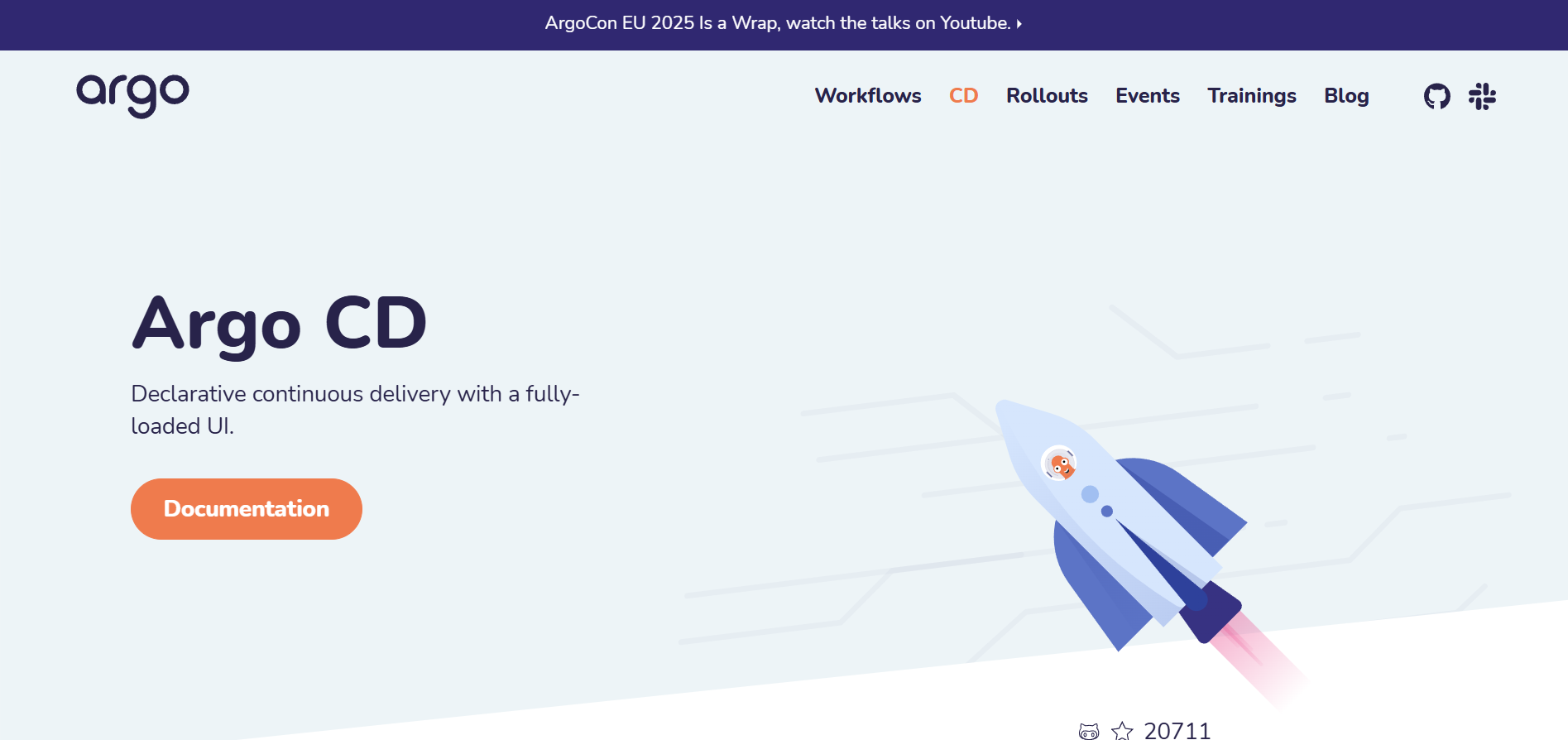
Argo CD is a GitOps continuous delivery tool that keeps Kubernetes clusters in sync with a declarative state stored in Git repositories. Once configured, it automatically applies updates, monitors drift, and rolls back changes when deployments fail.
Key features:
Best for: Teams adopting GitOps practices and seeking an audit trail for deploPortaineryments. It is particularly valuable for organizations running frequent releases across multiple clusters.

Portainer provides a lightweight user interface for managing Docker and Kubernetes environments. It simplifies deployment, configuration, and monitoring tasks, offering an alternative to command‑line tools.
Key features:
Best for: Smaller teams or organisations new to Kubernetes who want a straightforward way to manage clusters without heavy infrastructure. It is also used in educational settings to teach container management.

Prometheus is a leading open‑source monitoring system designed for cloud‑native environments. Grafana is a powerful visualization tool often paired with Prometheus for creating interactive dashboards. Together, they provide metrics collection, alerting, and time‑series visualization.
Key features:
Best for: Teams that need detailed metrics and customized dashboards without vendor lock‑in. Prometheus/Grafana setups are widely used by SRE and DevOps teams for infrastructure and application monitoring.

Kubecost, now an IBM company, is a Kubernetes-native cost monitoring and optimization tool that provides real-time visibility into cloud spending. It helps teams monitor, allocate, and optimize their Kubernetes expenses across clusters and cloud providers.
Key features:
Best for: FinOps and engineering teams that need detailed cost visibility and budgets. Kubecost is useful when organisations want to attribute costs to teams and encourage accountable usage.
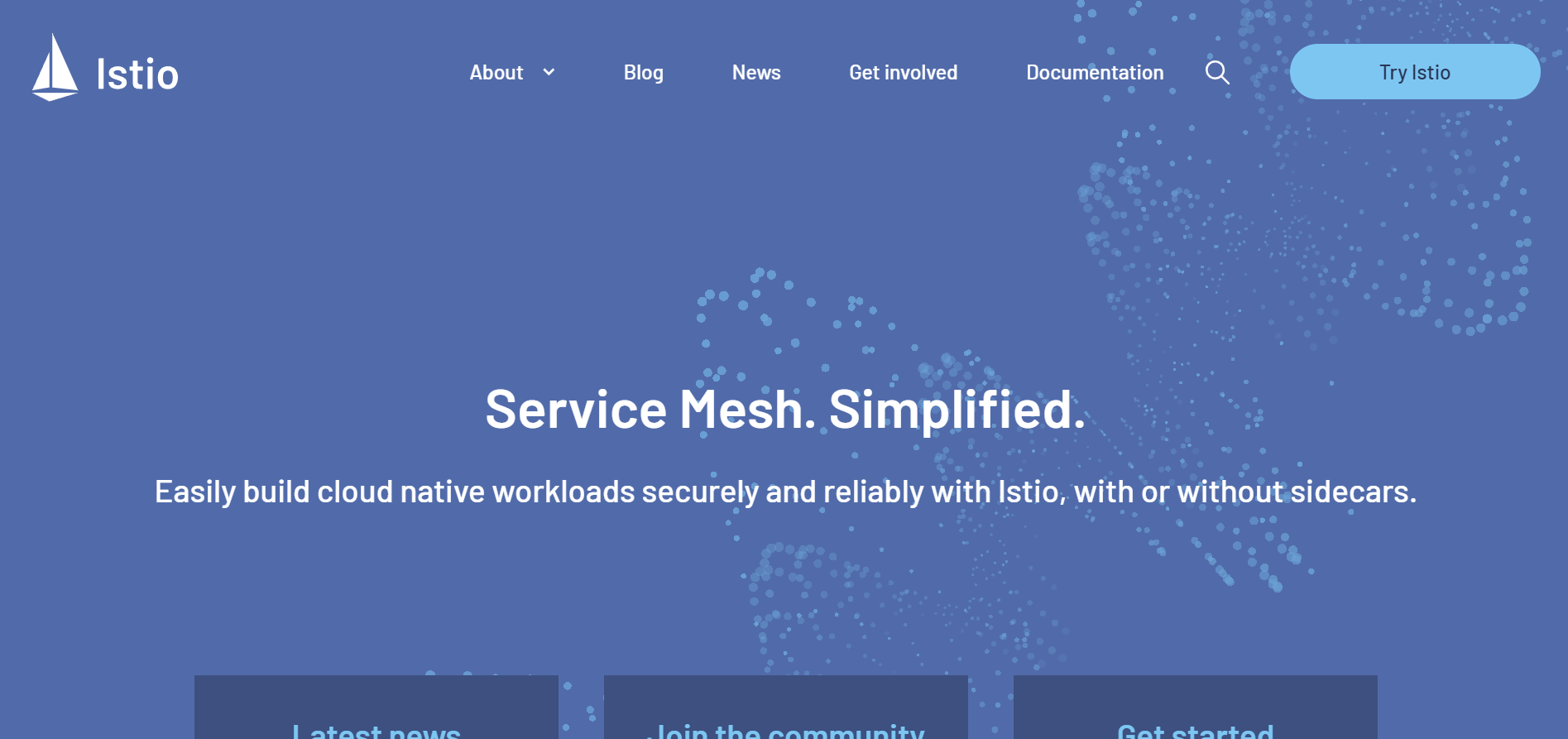
Istio is a service mesh that manages traffic routing, security, and observability for microservices running on Kubernetes. It abstracts service‑to‑service communication into a layer above the network, providing fine‑grained control without modifying application code.
Key features:
Best for: Organizations running microservices at scale that need advanced networking, security, and traffic management features beyond basic Ingress controllers. Istio is powerful for complex service topologies.

ScaleOps is an automated Kubernetes cost optimization platform that dynamically adjusts pod and node configurations in real-time to ensure resources are optimally utilized. It aims to minimize cost by scaling resources up or down based on actual demand rather than over-provisioning.
Key features:
Best for: Organizations seeking a fully automated, real-time Kubernetes cost optimization solution that integrates seamlessly into existing workflows and ensures compliance with data governance policies.

PerfectScale, now part of DoiT, is an autonomous Kubernetes optimization platform that leverages AI to continuously fine-tune resource allocation, ensuring peak performance while reducing costs.
Key features:
Best for: Organizations seeking a comprehensive, AI-driven solution for Kubernetes optimization that balances cost reduction with performance and reliability.
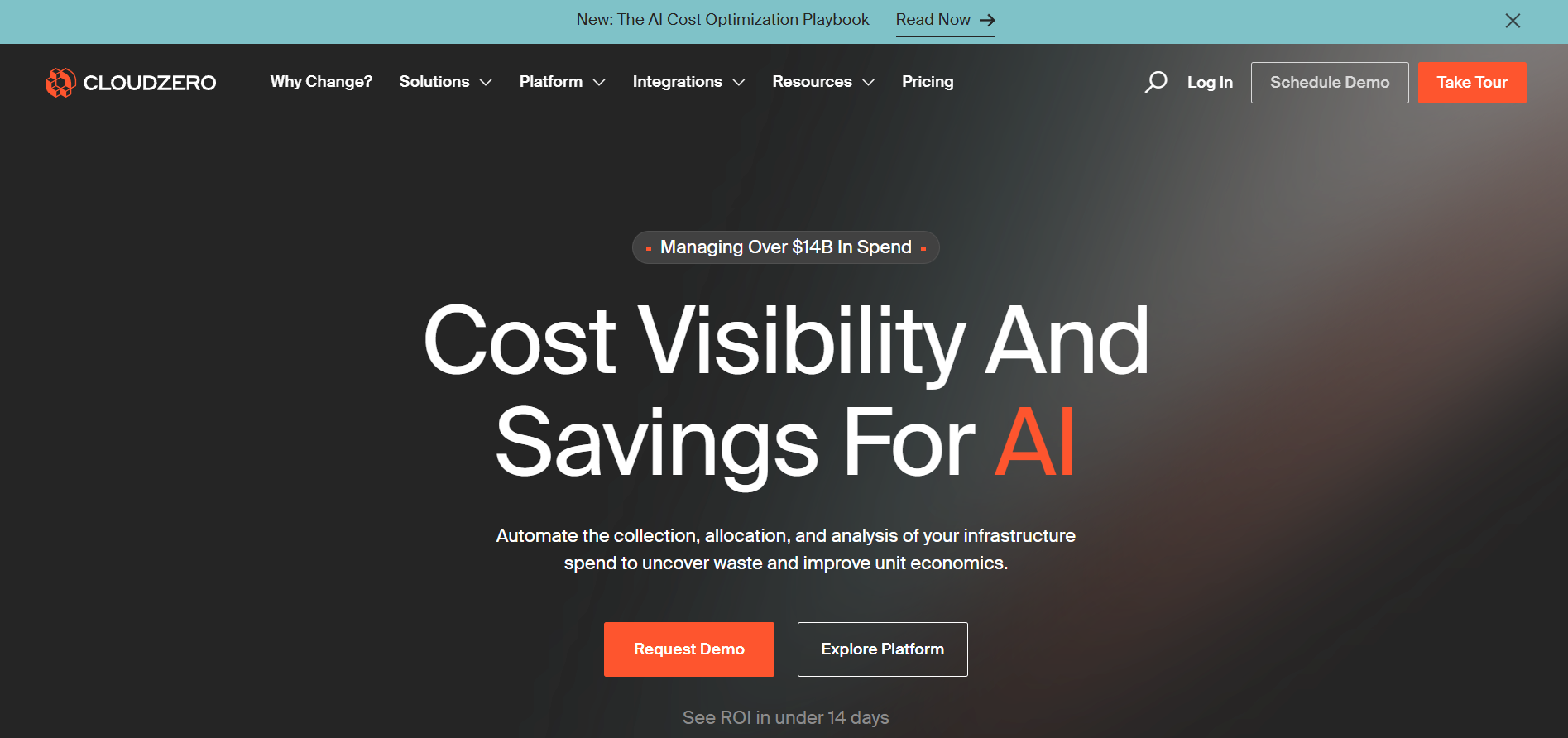
CloudZero is a cloud cost intelligence platform that provides engineering and finance teams with real-time visibility into Kubernetes spending. It enables organizations to allocate costs accurately, forecast future expenses, and identify optimization opportunities across multi-cloud environments.
Key features:
Best for: Organizations seeking a comprehensive, engineering-led approach to Kubernetes cost optimization. Ideal for teams that require detailed cost visibility, predictive budgeting, and the ability to align cloud spending with business objectives.
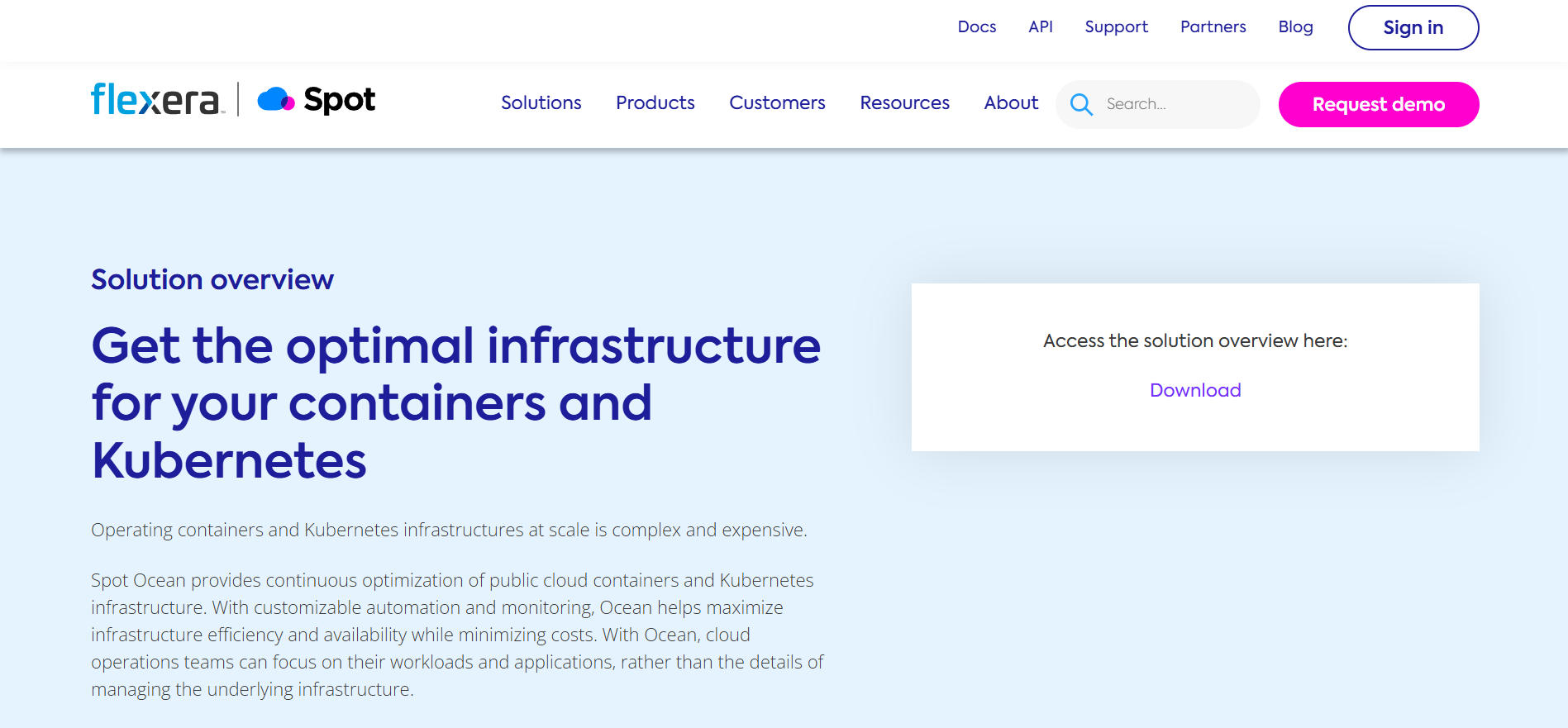
Spot Ocean, developed by Spot.io (a part of Flexera), is an intelligent Kubernetes infrastructure optimization platform that automates cost-saving strategies by dynamically provisioning the optimal mix of instance types and pricing options for containerized workloads.
Key features:
Best for: Organizations seeking to streamline Kubernetes infrastructure management while ensuring a continuous balance of cost, performance, and availability. Ideal for teams looking to automate cost-saving strategies and optimize container infrastructure.
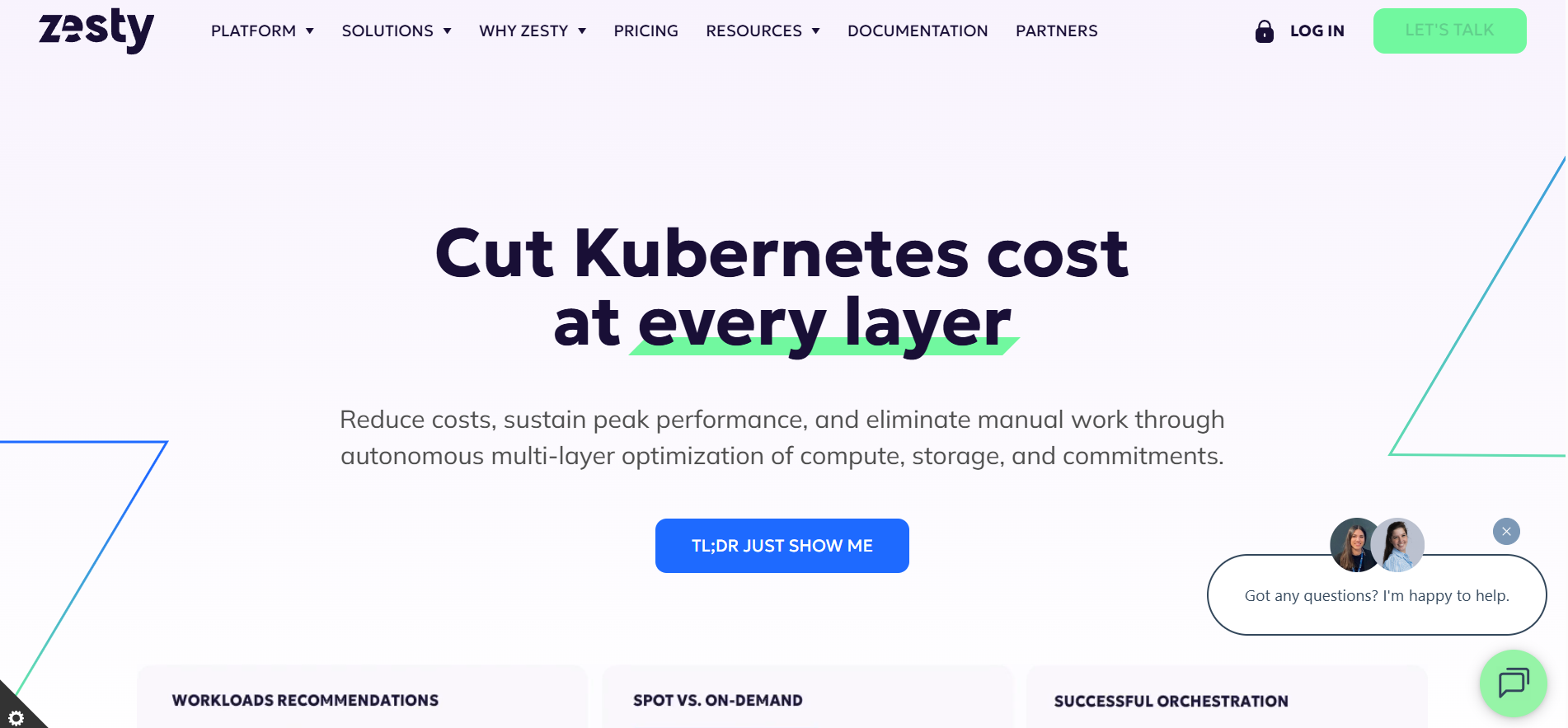
Zesty is an AI-driven cloud cost optimization platform tailored for Kubernetes environments. Its flagship solution, Kompass, offers real-time, automated optimization of compute and storage resources, aiming to reduce cloud expenses without compromising service-level agreements (SLAs).
Key Features:
Best For: Zesty is ideal for organizations operating large-scale Kubernetes clusters on AWS that seek to automate cloud cost optimization while maintaining high performance and reliability.
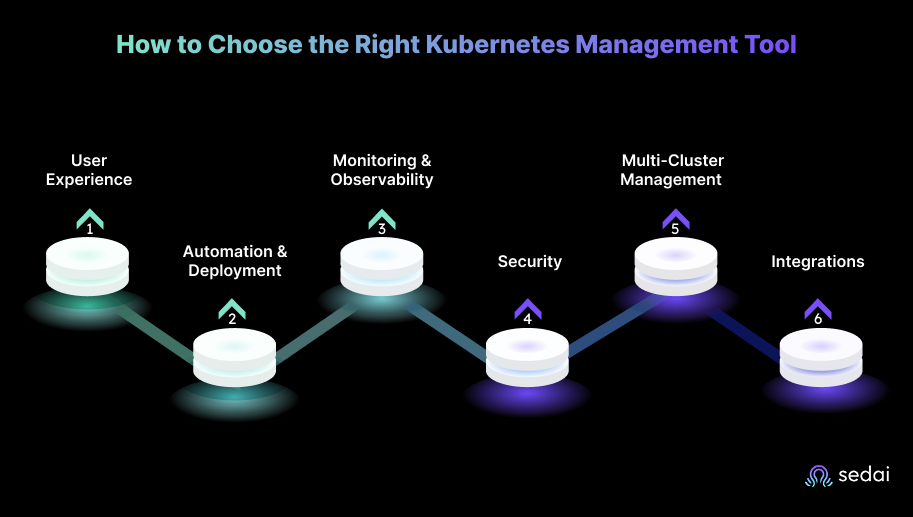
From our experience working with engineering teams running multiple Kubernetes clusters across clouds, the same pain points keep resurfacing.
Tools that worked fine when managing a single cluster start to crumble as environments scale. Automation gaps, inconsistent security policies, and poor multi-cluster visibility quickly translate into hours of firefighting and wasted budget.
We’ve seen firsthand that a tool’s value isn’t just in what it can show you but in what it can do on its own. Teams need solutions that take safe, real-time actions to maintain performance, availability, and cost efficiency without requiring constant human intervention. When a system can make those decisions autonomously, engineers can focus on improving applications rather than patching clusters.
Here are the other essential features we recommend focusing on when choosing the right Kubernetes management tool for your organization:
A tool should offer both UI and CLI options to accommodate different experience levels. A clean, intuitive interface helps new engineers onboard quickly, while powerful command-line capabilities give experienced admins efficiency. Balancing simplicity with depth is critical because a tool that’s hard to use slows the team down.
Strong automation is non-negotiable. Declarative configurations, self-healing clusters, and integration with GitOps, Helm, Kustomize, and CI/CD pipelines reduce human error and accelerate infrastructure changes. Without automation, teams are forced to react to issues after they occur, leaving performance and costs in the hands of guesswork.
Integrated monitoring, log aggregation, and alerting are vital for proactive management. Tools that provide comprehensive dashboards, real-time metrics, and log management enable effective troubleshooting. Native compatibility with popular observability stacks is a plus for teams that require in-depth visibility into their Kubernetes clusters.
Built-in RBAC, secrets management, policy enforcement, and vulnerability scanning are necessary for ensuring security and compliance. These features help reduce risks, allowing organizations to focus on scaling without compromising safety. Security capabilities should be robust and enterprise-ready.
The tool must support multi-cluster management and handle operations across various cloud environments. It should offer centralized control and seamless lifecycle automation, ensuring that as your infrastructure grows, the tool scales effortlessly with your needs.
Compatibility with other tools is crucial. A good Kubernetes optimization platform should integrate easily with GitOps workflows, CI/CD systems, service meshes, and container runtimes, ensuring that your cloud-native operations are cohesive and easily managed across different environments.
Kubernetes offers unmatched flexibility and scale, yet complexity is inevitable. With adoption soaring and most organizations experiencing at least one security incident, leaders must adopt disciplined Kubernetes management practices.
Most tools help visualize costs or surface inefficiencies, yet they stop short of taking action, leaving engineers to carry the burden of constant tuning and firefighting.
What changes the equation is autonomy. Instead of adding more dashboards, autonomous platforms close the loop between insight and remediation, continuously rightsizing and optimizing in production without waiting for human intervention.
That’s why engineering leaders are turning to autonomous systems like Sedai, which go beyond reporting by continuously optimizing resources in real time by closing the loop between insight and remediation.
By integrating Sedai's automation tools, organizations can maximize the potential of optimization in Kubernetes, resulting in improved performance, enhanced scalability, and better cost management across their cloud environments.
Join us and gain full visibility and control over your Kubernetes environment.
Yes, provided they employ safe, context‑aware policies. Sedai has executed 100,000+ production changes with zero service disruptions. Successful platforms incorporate behaviour modelling, gradual rollouts, and safeguards to avoid over‑aggressive scaling.
Calculate ROI by comparing cost reductions (e.g., rightsizing savings, reserved‑instance discounts) to licence fees. Run a pilot with clear KPIs: percent reduction in cloud bills, CPU/memory utilisation improvements, and time saved by engineering. In our experience, most tools pay for themselves within a few months, especially when they automate manual work.
Open‑source tools are excellent for cost visibility and recommendations, but often lack full automation and vendor support. Many teams start with open‑source solutions to gain awareness and then adopt commercial platforms for autonomous optimisation.
Given the pace of cloud and Kubernetes releases, evaluate your platform annually or when major business changes occur. Continuously monitor unit metrics such as cost per request and mean time to recovery. These will signal when adjustments are needed.
September 9, 2024
November 21, 2025

In 2025, managing Kubernetes costs is critical as cloud expenses can rapidly escalate without proper optimization. Kubernetes cost optimization tools go beyond monitoring, autonomously managing resources, and intelligently scaling to minimize waste while improving performance. Tools like Sedai utilize AI and reinforcement learning to continuously adjust resources in real-time, eliminating the need for manual intervention and ensuring cost-effective, efficient operations.
As engineering leaders, you know the challenge: Kubernetes offers incredible flexibility and scalability, but it can quickly spiral into an expensive and complex beast if not properly managed.
Traditional cost management tools only go so far. They may alert you to inefficiencies, but they often leave you with the burden of fixing them. That’s where the shift to autonomous systems comes in.
McKinsey’s research shows organizations that align cloud adoption with business outcomes achieve a 180% return on investment, whereas those that migrate legacy workloads without optimization often wait 12–18 months to break even. With Kubernetes becoming the de facto orchestration layer for microservices, engineering teams need tools that not only visualize costs but also act on them autonomously.
That is why we have created this guide that reviews leading Kubernetes cost optimization tools for 2025 to help you make informed decisions.
Kubernetes cost optimization is the process of managing and reducing cloud spending when using Kubernetes clusters. As organizations scale their applications in Kubernetes, cloud infrastructure costs can grow quickly if not carefully managed. Kubernetes enables flexibility and scalability, but without proper oversight, resources can become over-provisioned, idle, or inefficiently utilized, leading to unnecessary expenses.
Effective Kubernetes cost optimization focuses on minimizing waste, ensuring that resources are allocated based on actual demand, and maintaining a balance between cost, performance, and reliability.
That balance can’t come from static rules alone. Workloads shift, traffic patterns evolve, and what made sense last week might be wasteful today. The real opportunity in Kubernetes cost optimization lies in systems that continuously learn and adjust without forcing engineers to micromanage every configuration. Otherwise, you are just moving the problem from your cloud bill to your engineering backlog.

If you want to get serious about Kubernetes cost optimization, you first need to understand where the money is slipping through the cracks. After sitting with dozens of engineering teams, we’ve noticed the same cost drivers repeat themselves, whether the cluster runs a handful of services or hundreds.
Here are the most common ones:
These drivers are not just technical missteps. They are symptoms of a system that relies heavily on human configuration. As long as cost control depends on manual tuning of requests, scaling thresholds, and workload placement, inefficiencies will persist. That is why more teams are starting to look for systems that don’t just highlight these issues but adapt in real time to prevent them in the first place.
Kubernetes cost optimization tools are specialized software solutions that help address these cost drivers. They allow organizations to track, monitor, and manage the costs associated with running Kubernetes clusters by providing insights into resource usage, workload allocation, and scaling policies.
These tools help engineering teams and cloud administrators optimize their Kubernetes environments by offering capabilities like:
However, before reviewing tools, it's essential to understand that not all tools are created equal. It’s worth understanding the difference between automated and autonomous platforms. Automated systems execute predefined rules, for example, “if CPU>70 % for 5 minutes, add one pod”, but they are brittle. Any change in workload or architecture requires manual rule updates.
Autonomous systems, on the other hand, learn context, adapt to change, and act independently. They reduce human toil and catch inefficiencies before they cause outages. Moving from automation to autonomy delivers three significant outcomes: fewer nights spent firefighting, lower cloud costs through continuous rightsizing, and improved performance and availability.
The right tools can make all the difference when it comes to managing Kubernetes clusters at scale. Over the years, we’ve seen engineering teams experiment with a wide range of tools to streamline operations: scheduling, deployments, observability, cost management, security, and more.
But here’s the problem we keep running into: Traditional approaches to cost and performance management force a trade-off that rarely works in practice. These tools warn you about issues but leave your team to solve them manually.
This gap is precisely why autonomous systems are becoming essential. They don’t just point out problems: they act on them, reducing the cognitive load on teams while keeping both costs and performance in check.
Let’s start with the one that actually lives up to that promise.

When we say Sedai is #1, we’re not just throwing out a catchy phrase. It’s not about the shock value, but rather the approach. Most tools rely on rules-based automation. You set thresholds, and when usage crosses them, the system reacts. That works until workloads shift unexpectedly, and then the rules break.
What sets us apart is our patented reinforcement learning framework, which powers safe, self-improving decision-making at scale. Instead of just automating responses, it learns from your workloads, models how applications behave, and continuously improves its decisions with every change. That feedback loop is what keeps optimizations reliable, cost-effective, and aligned to performance goals.
That’s why a growing number of engineering teams are now using AI platforms like Sedai.
Sedai supports both autonomous scaling and co-pilot-based executions, where users are empowered to make key decisions on which workloads to execute, while the system handles other scaling actions automatically.
Sedai autonomously:
This real-time intelligence is what sets Sedai apart. Where most platforms show you what’s wrong, Sedai actually fixes it, adjusting commitments, rightsizing resources, and tuning workloads without manual input.
For enterprises, this means:
Key Features:
Best for: Engineering leaders who need continuous optimization across performance, availability, and cost. Enterprises adopting multi‑cloud or hybrid strategies and seeking to reduce manual effort will benefit most.

Rancher is a platform for managing Kubernetes clusters across on‑premises and public clouds. It provides a central control plane where administrators can create, upgrade, and monitor multiple clusters. Rancher abstracts away differences among providers, enabling consistent configuration and policy enforcement.
Key features:
Best for: Enterprises operating many clusters across different providers or on‑premises. Teams needing unified governance and RBAC controls will find it valuable.

Lens is a desktop application that gives developers an intuitive graphical interface for interacting with Kubernetes clusters. It aggregates multiple clusters into a single workspace, making it easier to explore resources, monitor pods, apply configurations, and troubleshoot issues.
Key features:
Best for: Individual developers and small teams who need to interact with multiple clusters without mastering command‑line operations. It is suited for local development as well as production cluster monitoring.

Helm is the de facto package manager for Kubernetes. It allows teams to define, install, and upgrade complex applications using “charts”, versioned templates containing Kubernetes manifests. Helm promotes the reuse of templates and helps enforce consistency across environments.
Key features:
Best for: DevOps teams responsible for deploying applications repeatedly across environments. Helm is useful when multiple microservices need consistent configuration and upgrades.

Kustomize is a native Kubernetes configuration tool that lets users customize raw YAML manifests using overlays rather than templating. It is built into kubectl, making it convenient for teams seeking declarative configuration without introducing a templating language.
Key features:
Best for: Teams who prefer plain YAML and want to avoid the complexity of templating. It works well for microservices architectures where each service needs a customized configuration across environments.

Argo CD is a GitOps continuous delivery tool that keeps Kubernetes clusters in sync with a declarative state stored in Git repositories. Once configured, it automatically applies updates, monitors drift, and rolls back changes when deployments fail.
Key features:
Best for: Teams adopting GitOps practices and seeking an audit trail for deploPortaineryments. It is particularly valuable for organizations running frequent releases across multiple clusters.

Portainer provides a lightweight user interface for managing Docker and Kubernetes environments. It simplifies deployment, configuration, and monitoring tasks, offering an alternative to command‑line tools.
Key features:
Best for: Smaller teams or organisations new to Kubernetes who want a straightforward way to manage clusters without heavy infrastructure. It is also used in educational settings to teach container management.

Prometheus is a leading open‑source monitoring system designed for cloud‑native environments. Grafana is a powerful visualization tool often paired with Prometheus for creating interactive dashboards. Together, they provide metrics collection, alerting, and time‑series visualization.
Key features:
Best for: Teams that need detailed metrics and customized dashboards without vendor lock‑in. Prometheus/Grafana setups are widely used by SRE and DevOps teams for infrastructure and application monitoring.

Kubecost, now an IBM company, is a Kubernetes-native cost monitoring and optimization tool that provides real-time visibility into cloud spending. It helps teams monitor, allocate, and optimize their Kubernetes expenses across clusters and cloud providers.
Key features:
Best for: FinOps and engineering teams that need detailed cost visibility and budgets. Kubecost is useful when organisations want to attribute costs to teams and encourage accountable usage.

Istio is a service mesh that manages traffic routing, security, and observability for microservices running on Kubernetes. It abstracts service‑to‑service communication into a layer above the network, providing fine‑grained control without modifying application code.
Key features:
Best for: Organizations running microservices at scale that need advanced networking, security, and traffic management features beyond basic Ingress controllers. Istio is powerful for complex service topologies.

ScaleOps is an automated Kubernetes cost optimization platform that dynamically adjusts pod and node configurations in real-time to ensure resources are optimally utilized. It aims to minimize cost by scaling resources up or down based on actual demand rather than over-provisioning.
Key features:
Best for: Organizations seeking a fully automated, real-time Kubernetes cost optimization solution that integrates seamlessly into existing workflows and ensures compliance with data governance policies.

PerfectScale, now part of DoiT, is an autonomous Kubernetes optimization platform that leverages AI to continuously fine-tune resource allocation, ensuring peak performance while reducing costs.
Key features:
Best for: Organizations seeking a comprehensive, AI-driven solution for Kubernetes optimization that balances cost reduction with performance and reliability.

CloudZero is a cloud cost intelligence platform that provides engineering and finance teams with real-time visibility into Kubernetes spending. It enables organizations to allocate costs accurately, forecast future expenses, and identify optimization opportunities across multi-cloud environments.
Key features:
Best for: Organizations seeking a comprehensive, engineering-led approach to Kubernetes cost optimization. Ideal for teams that require detailed cost visibility, predictive budgeting, and the ability to align cloud spending with business objectives.

Spot Ocean, developed by Spot.io (a part of Flexera), is an intelligent Kubernetes infrastructure optimization platform that automates cost-saving strategies by dynamically provisioning the optimal mix of instance types and pricing options for containerized workloads.
Key features:
Best for: Organizations seeking to streamline Kubernetes infrastructure management while ensuring a continuous balance of cost, performance, and availability. Ideal for teams looking to automate cost-saving strategies and optimize container infrastructure.

Zesty is an AI-driven cloud cost optimization platform tailored for Kubernetes environments. Its flagship solution, Kompass, offers real-time, automated optimization of compute and storage resources, aiming to reduce cloud expenses without compromising service-level agreements (SLAs).
Key Features:
Best For: Zesty is ideal for organizations operating large-scale Kubernetes clusters on AWS that seek to automate cloud cost optimization while maintaining high performance and reliability.

From our experience working with engineering teams running multiple Kubernetes clusters across clouds, the same pain points keep resurfacing.
Tools that worked fine when managing a single cluster start to crumble as environments scale. Automation gaps, inconsistent security policies, and poor multi-cluster visibility quickly translate into hours of firefighting and wasted budget.
We’ve seen firsthand that a tool’s value isn’t just in what it can show you but in what it can do on its own. Teams need solutions that take safe, real-time actions to maintain performance, availability, and cost efficiency without requiring constant human intervention. When a system can make those decisions autonomously, engineers can focus on improving applications rather than patching clusters.
Here are the other essential features we recommend focusing on when choosing the right Kubernetes management tool for your organization:
A tool should offer both UI and CLI options to accommodate different experience levels. A clean, intuitive interface helps new engineers onboard quickly, while powerful command-line capabilities give experienced admins efficiency. Balancing simplicity with depth is critical because a tool that’s hard to use slows the team down.
Strong automation is non-negotiable. Declarative configurations, self-healing clusters, and integration with GitOps, Helm, Kustomize, and CI/CD pipelines reduce human error and accelerate infrastructure changes. Without automation, teams are forced to react to issues after they occur, leaving performance and costs in the hands of guesswork.
Integrated monitoring, log aggregation, and alerting are vital for proactive management. Tools that provide comprehensive dashboards, real-time metrics, and log management enable effective troubleshooting. Native compatibility with popular observability stacks is a plus for teams that require in-depth visibility into their Kubernetes clusters.
Built-in RBAC, secrets management, policy enforcement, and vulnerability scanning are necessary for ensuring security and compliance. These features help reduce risks, allowing organizations to focus on scaling without compromising safety. Security capabilities should be robust and enterprise-ready.
The tool must support multi-cluster management and handle operations across various cloud environments. It should offer centralized control and seamless lifecycle automation, ensuring that as your infrastructure grows, the tool scales effortlessly with your needs.
Compatibility with other tools is crucial. A good Kubernetes optimization platform should integrate easily with GitOps workflows, CI/CD systems, service meshes, and container runtimes, ensuring that your cloud-native operations are cohesive and easily managed across different environments.
Kubernetes offers unmatched flexibility and scale, yet complexity is inevitable. With adoption soaring and most organizations experiencing at least one security incident, leaders must adopt disciplined Kubernetes management practices.
Most tools help visualize costs or surface inefficiencies, yet they stop short of taking action, leaving engineers to carry the burden of constant tuning and firefighting.
What changes the equation is autonomy. Instead of adding more dashboards, autonomous platforms close the loop between insight and remediation, continuously rightsizing and optimizing in production without waiting for human intervention.
That’s why engineering leaders are turning to autonomous systems like Sedai, which go beyond reporting by continuously optimizing resources in real time by closing the loop between insight and remediation.
By integrating Sedai's automation tools, organizations can maximize the potential of optimization in Kubernetes, resulting in improved performance, enhanced scalability, and better cost management across their cloud environments.
Join us and gain full visibility and control over your Kubernetes environment.
Yes, provided they employ safe, context‑aware policies. Sedai has executed 100,000+ production changes with zero service disruptions. Successful platforms incorporate behaviour modelling, gradual rollouts, and safeguards to avoid over‑aggressive scaling.
Calculate ROI by comparing cost reductions (e.g., rightsizing savings, reserved‑instance discounts) to licence fees. Run a pilot with clear KPIs: percent reduction in cloud bills, CPU/memory utilisation improvements, and time saved by engineering. In our experience, most tools pay for themselves within a few months, especially when they automate manual work.
Open‑source tools are excellent for cost visibility and recommendations, but often lack full automation and vendor support. Many teams start with open‑source solutions to gain awareness and then adopt commercial platforms for autonomous optimisation.
Given the pace of cloud and Kubernetes releases, evaluate your platform annually or when major business changes occur. Continuously monitor unit metrics such as cost per request and mean time to recovery. These will signal when adjustments are needed.